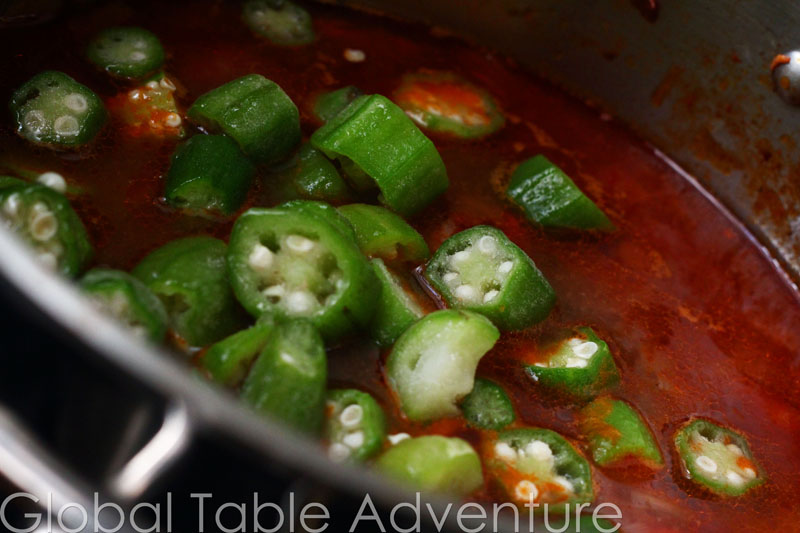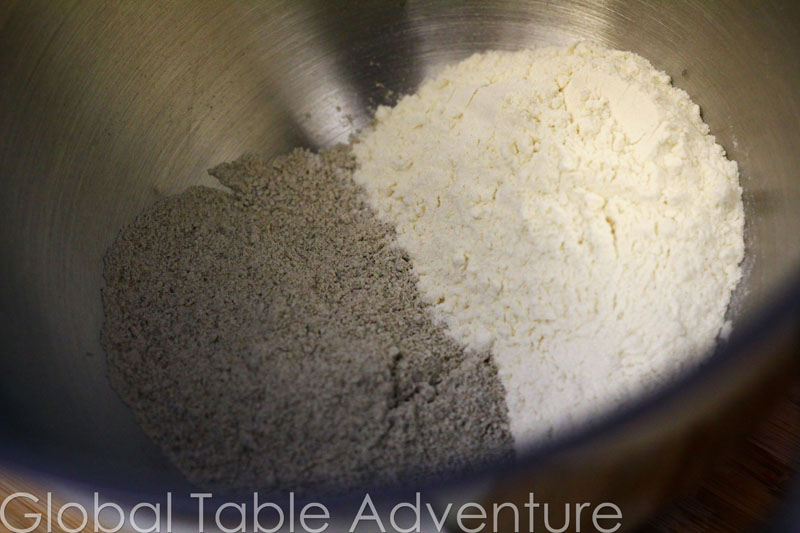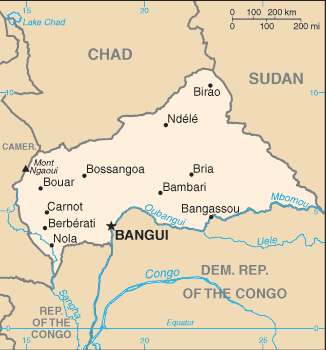Please note: Due to last week’s illness, this meal review covers both Central African Republic & Chad. I’m not sure if anyone’s keeping track, but I haven’t had the best luck with yucca. At this rate, we’ll never be friends. First, there was the Baton de Manioc fiasco- for our Angolan Global Table. That night, after eating several of the batons, I blacked out – lost hearing and sight – crashed to the floor and went into shock. The scariest part? I was holding Ava. Thankfully Keith caught her as she was slipping out of my arms – head first, I might add – and kept her from tumbling down onto the tile. I still get choked up thinking about what could have happened that night. The doctor blamed dehydration, but I’m pretty sure overindulgence in yucca had something to do with it. Second, there was the yucca based sweet, Getuk Lindri – for our Brunei Global Table. Even after doing hours of research I was unable to make a good batch of Getuk Lindri. …
Read More
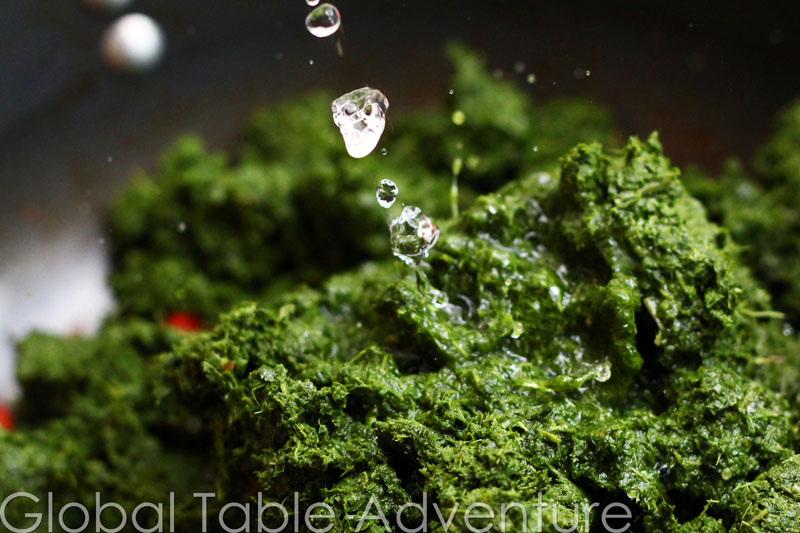
Serves 4-6 Cassava leaves are highly fibrous, dense and grassy. We found ours frozen and “ground” at Ebutte Tropical Market – which saved us a lot of sweat around a mortar and pestle. You could easily double the aromatics in this recipe as the flavors rather get lost behind the domineering cassava. Ingredients: red palm oil 1 large onion, chopped 2 tomatoes, chopped 1 1/2 lbs fresh ground cassava leaves 1 Tbsp peanut butter water salt pepper Method: Thaw out some fresh ground cassava leaves. Over medium heat, cook chopped onion in a drizzle of red palm oil. Note how the oil stains the onions gold. Add tomatoes. And the cassava leaves. The smell will transport you to hay-ville. If such a place exists. Add enough water to keep things moist and sludgey, so that the mixture doesn’t burn. Bring to a simmer. Stir in peanut butter. Stew over low heat, covered, for about 30 minutes. Serve immediately with an Adventurous spirit. Stewed Cassava Leaves Votes: 0 Rating: 0 You: Rate this recipe! Print Recipe …
Read More
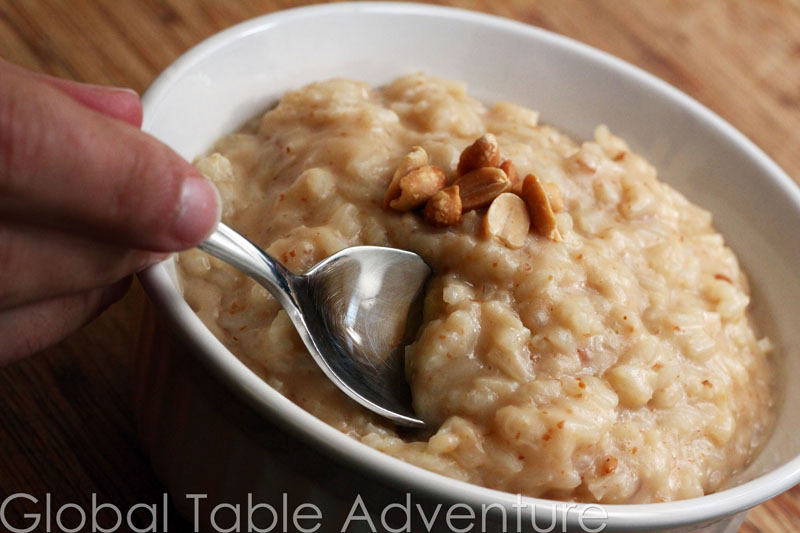
Serves 2-4 If you’re looking for a sweet treat, but the pantry is rather dry, this African peanut butter rice might do the trick. The dish reminds me of peanut butter rice pudding – thick, sweet, and comforting. Ingredients: 1/2 cup white rice 1 1/2 cups water 1/4 cup natural peanut butter 1/4 cup sugar 1/8 cup water additional water, as needed Method: Bring water to boil. Add rice and simmer, uncovered for 15 minutes 2. Meanwhile, mix together peanut butter, sugar, and 1/8 cup water. Natural peanut butter is best because then you can control how sweet your dessert is. I could eat this straight from the bowl. Mmm. When the rice is almost done cooking… … pour peanut butter mixture over rice and stir in. Continue simmering until rice is perfectly tender. Add water as necessary to keep the consistency loose, like rice pudding. Enjoy warm or cold, with a big sweet tooth. Sweet Peanut Butter Rice | Bouiller Votes: 0 Rating: 0 You: Rate this recipe! Print Recipe If you’re looking for …
Read More
Makes about 2 cups Raw seeds give Egusi sauce grassy flavor and a little bit of texture. The sauce is popular in central Africa, and can be served over vegetables, meats, and fish. Ingredients: 1 small onion 1 tomato 1 chili pepper (I used a poblano from my garden, but you can go as spicy as you want with this recipe) salt red chili powder, to taste 1 1/2 cups ground egusi 1/2 cup water (or as needed) Method: Hunt down some ground melon seeds. I found these at our local African market. Latino stores have pepitas, or pumpkin seeds, which are an acceptable substitute. In a food processor, add tomato… Coarsely chopped onion … And a chili pepper. I left the poblano on the plant long enough that it turned red. The extra time on the plant made it sweeter 🙂 Puree everything together… Add it to a small pot with the egusi… Some salt and pepper… And water… Things don’t look so tasty here… but as the water mixes in, things smooth out. …
Read More
Happy Saturday! Nothing like starting your day off with a little grubworm stew… And here are some images of Central African Republic’s land…
Read More
I bought an apron this summer. It was time to face facts. I’m 31 years old, I’m a mess in the kitchen, and I’m not getting any cleaner. Flour is probably my only regular fashion accessory (although I do love necklaces). In addition, flour is almost always my only chance at “makeup.” As I twirl through the kitchen, I regularly dust flour on my nose, through my hair, and – yes – even on poor little Ava. She’s really a good sport though – she hardly ever notices. So, in honor of flour’s persistent role in my life, let’s talk … flour. This photo shows millet and all-purpose, wheat flour. Around the world, people use all sorts of flour in their food, depending on access to native plants, special diets, and basic needs. In Africa, the most common are flours are Millet, Cassava, Tapioca, Teff, and wheat. In day to day life, flour is typically used to make one of the following items: porridge thick and starchy fufu dumplings fried beignets/doughnuts About flour in this …
Read More

This week we’re eating a double feast from two neighboring countries – Central African Republic and Chad. I had a lot of time to ponder our menu, as there is little else to do while tossing in feverish delirium. Thank goodness we have a good African market in Tulsa, where I can find casssava leaves and ground melon seeds… and really explore the flavors of Africa. CENTRAL AFRICAN REPUBLIC Stewed Cassava Leaves [Recipe] Dark green leaves from the cassava plant stewed with tomato, onion, and peanut butter. Egusi Sauce [Recipe] Ground melon seeds cooked into a sauce with onion, tomato, and chili pepper. We served it with grilled chicken, but this sauce can be served over rice, vegetables, or other meats. Sweet Peanut Butter Rice (Bouiller) [Recipe] White rice sweetened with sugar and natural peanut butter. CHAD Lamb Stew with Okra [Recipe] Pieces of lamb slowly simmered with onion, bell pepper, and okra. Millet Balls [Recipe] A blend of white and millet flour cooked in a double boiler, then formed into balls and simmered. Spiced …
Read More
The dusty, rolling plains of Central African Republic (CAR) lead to fertile river beds in the south, and sandy desert in the northeast. Many people live on stewed greens, cooking whatever is available, including cassava (recipe), spinach, or kale. Groundnut butter (a.k.a. peanut butter) is used to add flavor and protein to food when meat is unavailable. Most often, greens are served with rice or foutou – a pasty mash of plantain or cassava. Groundnut butter is also used to add flavor to local desserts. Sometimes the creamy spread is cooked into sweetened rice for a particularly addictive treat which looks like tan rice pudding (recipe). Egusi, or melon seed, is particularly popular in Central African Republic. When finely ground, combined with hot chili peppers, tomato, and onion, the seed makes a thick sauce (recipe) to add interest to plantains, yams, rice, fish or grilled meat.
Read More

